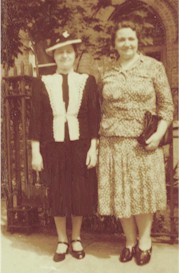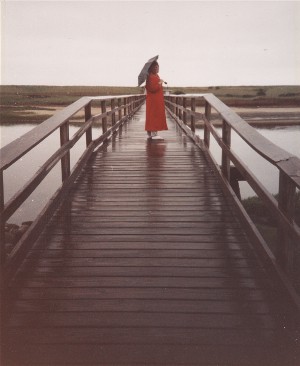
These are my two grandmothers in the mid-1940s, when they were a few years younger than I am now.
That’s my mother’s mother on the left — the small, straight-backed, serious woman — the one who saved my life with her Old World medicine magic (see poem below).
My father’s mother is bigger, softer-looking, but was no less strong. She remembered growing up in Sklody, Poland, admiring her third cousin, who became the famous Madame Marie Curie. Strong women, all.
But how old they look to me now, even though, today, I am older than they are in that photo. Life was hard for them — very serious business, with five kids each and hard-working blue-collared husbands. They cooked well, cleaned well, and passed along to me their matriarchal genes — the blessings and curse of my crone heritage.
On this day of memory, I remember my grandmothers.
HEART OF ROM
Cyganka! My grandmother shouted
as I bounded off the front stoop
onto the wet city street,
propelled by the promise of stolen kisses
and the musky taste of Tangee
still slick on my lips.
Gypsy! Even the word
brought blood rushing
to the pit of my stomach.
How I wished for the wild hair,
dark eyes, skin like old copper,
for the freedom to gleam
like crystal when I walk,
for a wisdom ancient as the land,
as the sweep of continents,
the shriek of willful wind
through openings in stones.
Cyganka! She hurled it
like an epithet,
but I role it like a broom
over landscapes grown deaf to her fears.
She named me true, my Polish grandmother
— a small strong-handed woman
with gypsy fire in her voice
and a back turned straight
against truths too bold to hold.
Yet, they tell me once,
as I lay young and dying
lungs rattling with rifts of air,
fever lighting my face to flame,
(the doctor came and went,
scowling at the earth) —
in the draped and stifling room,
she unfolded her family secrets:
holy candles, crystal cups,
vials of spirits, leeches, as
my mother watched from shadow,
willing demons away with her eyes.
They tell me when the priest arrived,
surprised to find the child alive,
he never commended on the faint red circles
following the tender length of spine,
or the sprinkling of blood marks
along the back, like the bites
of mythic bats or the denounced
touches of wizened old wives.
And so I keep signs
of these grandmothers, still
–in fragrant herbs sprinkled in tea,
in shells and stones arranged on shelves,
in faint red circles, drawn in firelight.
Cyganka! I call to my daughter,
offering gifts of crystals
that fire the sky
where she walks.
(copyright EF 1980)



